CHINESE TOURISM BUSINESS
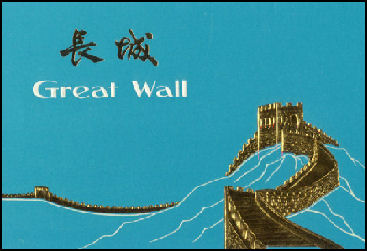
Great Wall postcardTourism is a huge labor intensive industry that generates lots of jobs and has a large multiplier effect. Not only does it creates jobs for people working in the tourist industry itself but it also produces jobs in construction, transportation, agriculture, craft production, fishing and livestock raising.
China ranks fifth in the world in tourism revenues with 55 million visitors and $42 billion in 2007.The tourism sector earned $96 billion in 2005 with $66 billion from domestic travelers and $29.3 billion from international travelers. Tourism was expected to grow 8 percent in 2006. Fueled by growing middle-class and government support, China's tourism industry recorded a 9 percent jump in revenue in 2009, to 1.26 trillion yuan ($189 billion). This year, total revenue is expected to reach 1.44 trillion yuan, a year-on-year jump of 14 percent , according to state media.Some predict earnings will reach $300 million by 2015. Tourism accounts for 3.7 percent of the national economy.
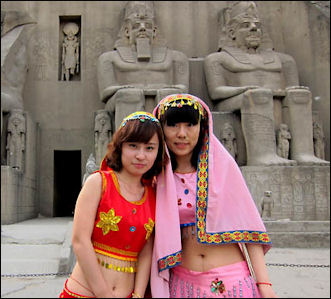
tourists at World Park
Tourism has grown rapidly in China. China is spending a lot of money promoting tourism and relaxing laws governing the tourist industry. Over the coming years Asia is supposed to experience the greatest growth in tourism, with the lion share of the growth occurring in China. China was hurt by SARS but recovered quickly. China is predicted to be world’s most popular tourist destination by 2015.
Tourism is a fickle industry affected by local, regional and world economic and political conditions. In 2003, tourism around the globe was affected by the Iraq war and the SARS scare. Many places that nothing to do these problems and were in different continents were hurt. Some people are afraid of traveling to China. Paul Theroux wrote in the 1980s: "Tourists have been known to disappear down elevator shafts and the claims by tourist against the China International Travel Service for injuries, missed cities and sickness are astronomical."
Global tourism experts say that for China’s tourism really to take off China needs to develop its infrastructure and offer visas on arrival and spread the three “golden weeks” to avoid the made scramble around New Year.
Websites and Sources: China Outbound Tourism Research Institute china-outbound.com ; China National Tourist Office (CNTO): CNTO
Tourism in the Mao Era
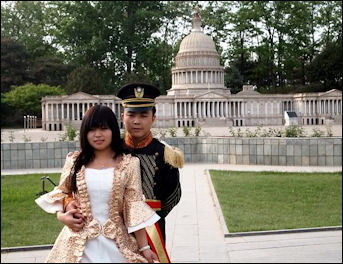
tourists at World Park
In the Mao era, there were restrictions on travel within China. Visas were required on internal passports to travel from one town to another; and when they arrived at their destination hotel guests were required to register with the police. Some communes and factories provided summer camps and spas for their workers. In 1981 the Beijing airport was just military huts
Few Chinese traveled in the Mao era. Ordinary people. couldn't travel abroad. The only people allowed to travel abroad were the Communist elite, diplomats, spies, opera singers, musicians, dancers, world class athletes, and other privileged people. For most ordinary people, vacations were an unknown concept. Model workers were rewarded with week-long beach holidays at state-run sanitariums. There were no souvenir shops, little bargaining and no tipping.
Going to a foreign country was like going to the moon. Those that did travel abroad got special permission to leave and often never came back. Anyone who expressed interest in traveling abroad for fun was regarded as ideologically suspect and ran the risk of being labeled as a counter-revolutionary. Many of the people who tried to travel to China in the 1950s and 60s and actually made inside the country ended up in prison. Many of the foreigners that chose to stay in China after the Communist takeover in 1949 — including doctor, businessmen and missionaries — also ended yo in prison.
Foreigners are often prohibited from staying at cheap hotels and forced to stay in expensive hotels reserved for foreigners. It was not uncommon to stay in a 500-room hotel with only seven guests.
Tourism During the 2008 Olympics in Beijing
The number of foreign tourists visiting China fell 2 percent to 130 million in 2008. The drop was blamed on the global economic slowdown and visa restrictions imposed before the Olympics.
After the Olympics there were loads of empty hotels in Beijing. The Olympics did however generate long term interest in China and many travel companies said they were besieged with inquires about tours after the games.
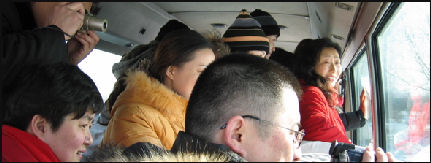
Chinese tourists checking out....
Chinese Tourists
For the growing middle class tourism has become a way for them to spend their extra cash. In a survey in 2007 of rich Chinese listed traveling as their top leisure activity while spending time with their families places a distant seventh. Australia, France and the United States were the most favored international destinations while the southern Chinese resort of Sanya ranked as the top domestic leisure destination.
The most common form of travel is visiting one’s home town or village during the New Year holiday. One third of the Chinese traveling on trains are people heading for meetings. Business trips are usually holidays with a meeting or two thrown in, and good managers are often rewarded with a paid holiday to somewhere instead of a bonus.
Like their Japanese counterparts, Chinese tourist are very fond of snapping pictures and traveling in groups. Nouveau riche tourists have a reputation for being loud and having long shopping lists.
Chinese tourists often travel groups in which everyone wear identical tour caps, carry matching tour bags and follow a guide carrying a flag. They usually get around in buses that have been hired by their factory, cooperative or work unit.
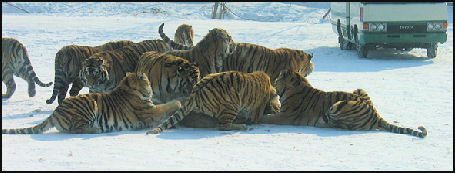
tigers at an animal park in Harbin
The Chinese generally don't own very much and they travel light. Some travel with no bag, and only a toothbrush in the pocket. On the trains, Chinese tourists sometimes sit around in their long underwear or pajamas and put on a coat when the go to the meal car.
See Tipping, Business Customs
In the Lonely Planet Guide of China, Brian Malone described witnessing the arrival of the 1.5 millionth customer to the Beijing Hotel. "About 20 photographers were waiting to record this event...A large black limousine came up, stopped and had the door opened by a porter. The camera starting clicking and out stepped the most ragged peasant we ever saw in all of Beijing. He was warmly welcomed into the hotel and brought through he swinging doors. Without further delay — after the disappearance of the camera crews — the 'lucky' guest reappeared through the swinging doors and disappeared back into the black limo."
Chinese Tourism Business
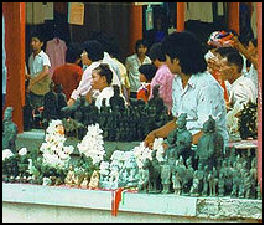
Trinket seller in Xian
Many Chinese want to open businesses geared to foreign tourists because they seem to offer the largest potential profit. Two beers at some restaurants for tourists, sell for seven dollars, or two weeks pay for the average peasant. Many Chinese specialize in selling fake stone statues and bronzes to foreign tourists, and there are even factories that specialize in fakes. Even the People's Liberation Army id involved in the hotel business.
Tourist who travel on arranged tours are often ripped off. One couple who wrote to Lonely Planet described a group tour which consisted only of them. As part of their $350 a day package they were fed at restaurants which cost other foreigners about $4 a price a meal. Restaurants that charged about $7 were considered too expensive.
Many of China’s most famous tourist sites are managed by politically-connected business like Beijing Zhongdian Investment Corp, which earned by more than $600 million in 2006 running sites such as Hongchun in Anhui Province and Zhongdian near Tibet in Yunnan. The company is notorious for cheating villagers whose land is developed for tourism and giving them very little of the hefty admission fees they charge tourists. The sites themselves are often developing in a way that is ugly and not culturally sensitive. Beijing Zhondian is controlled by Huang Nubo, a former Communist Party Propaganda department section chief. He is said to worth over $500 million.
More than 530,000 people visited Hongchun in 2006, paying more than $2.3 million in entrance fees. Of this two thirds went to Beijing Zhongdian. Most of the rest went to the county and town government. Residents of the town said they got only $90 each even though they were asked to do thing like not raise animals and keep their windows closed.
Club Med, in financial trouble in the late 2000s, was looking to China and upmarket customers there to turn itself around.
Chinese Tourist Attractions

Dwarf Theme Park (
see Entertainment Under Recreation)
Many popular tourist sights in China are swamped with Chinese tourists who seem more interested in cheesy souvenirs, carnival games and tacky cable car rides and mazes and other amusements than the sighs themselves. Tourist areas often have a take-your-picture booths and temples often feature monks selling postcards. The "Dragon Cave" near Dalien has plastic stalactites, painted fiberglass rocks and tables surrounded by fake moss.
Items for sale t the Badaling Great Wall of China souvenir stands include "I Climbed the Great Wall" T-shirts, talking panda dolls, cuckoo clocks that play "The East is Red," plastic reclining Buddhas with lightbulbs in their mouths, Deng Xiaoping pocket watches and alarm clocks with a Red Guard waiving her Little Red Book. There is also a camel on which tourists can have their picture taken.
Some Chinese tourist attend Cultural Revolution vacations and drink mare's milk, shovel cow dung, eat boiled mutton, sing revolutionary songs and reminisce about times of "eating bitterness." Westernized Chinese kids that dragged along don't have such a good time.
There were 37 UNESCO World Heritage Sites in China as of 2009
Minority Villages in China
Mitch Moxely wrote in the Asian Times, China “is home to a growing number of minority-themed tourists parks, such as the Dai Minority Park in southwest China's Yunnan province. [Source: Mitch Moxley, Asia Times, October 29, 2010]
There, villagers are forbidden from making major changes to their traditional wooden-stilt homes and are paid to perform a daily water-splashing ritual for which they are famous. The real water-splashing festival normally lasts just three days a year. The park, owned by and catering to majority Han Chinese, welcomes a half-million tourists per year.
The most famous minority park in China, Beijing's Nationalities Park, for years featured English signs with the unfortunate translation "Racist Park". In many parks, the ethnic minorities featured are actually Han Chinese dressed up as natives.
Communist-Themed Tourism in China
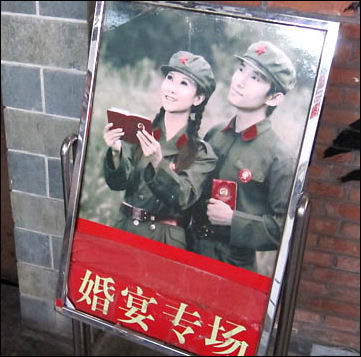
Cultural Revolution Restaurant In 2005, Beijing launched a drive to promote “red tourism,” believing it would reinvigorate the “national ethos” of visitors and the economies of mostly poor, landlocked areas such as Yanan in Shaanxi; Shaoshan, Mao Zedong's Hunan hometown; and Xibaipo in Hebei, another Communist base. As elsewhere in modern China, capitalism marches in step with the political status quo. [Source:Tania Branigan, The Guardian, September 27, 2009]
The red tourism drive was launched with a promise to inspire young people and “consolidate their faith in pursuing the road of socialism with Chinese characteristics.” According to official’ perhaps inflated — statistics, visits to individual sites reached 272 million in 2008, an increase of more than 18 percent year-on-year; while income from red tourism rose to 124 billion yuan, up 35 percent.
Russell Leigh Moses, a Beijing-based analyst, told The Guardian: “It says something about red tourism that the party has to be so full square behind it. Twenty years ago, people would go to these sites by themselves...Now it was “a loyalty test.”
Still some visitors to these places seem moved, Forty-year-old Geng Jianchan was celebrating his fourth visit to Yanan by buying three gold busts of Mao from a vendor outside the chairman's cave-house. “Every time I'm depressed in work and daily life, or I feel under pressure, I come here to look for his spirit,” he told The Guardian, adding Mao's ideals were just as relevant to contemporary businessmen such as him: “It's his spirit of never being defeated and fighting hard when in difficulties. He experienced ups and downs. That always encourages me.”
China's Great Museum Race
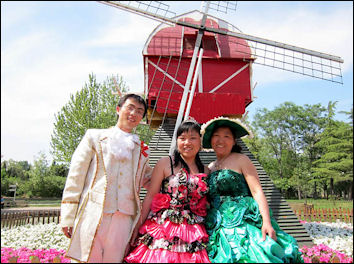
tourists at World Park According to the Global Times: “China is enjoying a surge of new museum openings. A number of new museums have recently opened their doors in China, with hundreds currently under construction across the country. The efforts is winning widespread applause for boosting people's cultural life, but also generating criticism for the problems caused by the race for rapid construction.” [Source:Wu Ziru, Global Times, May 17, 2010]
“Visiting museums is always one of my favorite things while traveling in different cities,” Wang Juan from Xi'an, Shaanxi Province told the Global Times. “It's one of the most efficient ways to understand the city's culture and history.” Xian is among the cities with the largest number of museums. Between 2010 and 2013, the city's 47 museums will grow to 100, according to an announcement at a meeting on cultural relics held in Xi'an.
“Xian is not alone in the fierce battle for the title of the No.1 city with the largest number of museums,” Wu Ziru wrote in the Global Times. “Competition was ignited in 2005, when the central government expressed for the first time its supportive attitude toward building private museums and released a series of laws and regulations to promote museums of all levels. Almost immediately after the announcement, the government of Dongguan, Guangdong Province, declared it would spend 30 million yuan ($4.4 million) to open new museums.”
In 2006, a 100-museum plan was drawn up by Shanghai municipal government, stating that its 100-museum goal would be accomplished within five years. Meanwhile, the city of Chengdu, Sichuan Province, also said it will make efforts to build more museums and become the city with the largest number of museums in western China.
Zhang Bai, former vice-director of the National Cultural Relics Bureau and general director of the Chinese Society of Museums, told the Global Times opening more museums in China should be encouraged, since China still lags far behind Western countries in terms of the numbers of museums. However, Zhang also expressed his concerns toward the recent mass building of museums. “Opening more and more museums can't solve the problem forever, because it is the collections and displays function, not just the constructions themselves,” he said. The lack of money is always a problem haunting museums in China, according to Zhang. Except for several large-scale museums run by the central government, many museums once built face funding shortages, making it difficult to afford new pieces and upgrade existing equipment and facilities.
Tourism in Tibetan Areas
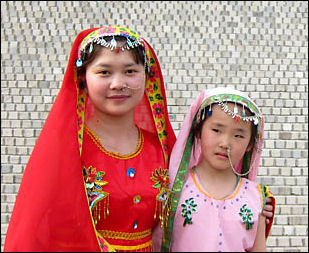
tourists at World Park Reporting from Jiaju, China Mitch Moxely wrote in the Asian Times,”In 2005, the National Geographic China magazine named this ethnic Tibetan village in western Sichuan province, sprawled over a valley amid snow-capped mountains, China's most beautiful. Depending on how you look at it, that distinction was either a blessing or a curse. During the national day holiday in October, middle-class Chinese tourists from Sichuan's capital, Chengdu, and beyond, literally crawl over this "Model Tibetan Village", as a regional brochure puts it. For an entrance fee
of 30 yuan (US$4.48), tourists wander through locals' multi-storey stone homes and pose for pictures on rooftops decorated with drying corn. [Source: Mitch Moxley, Asia Times, October 29, 2010]
On almost every rooftop, alongside faded Tibetan prayer flags, flies the red and yellow flag of the People's Republic of China. "It's beautiful," a young woman from Chengdu, visiting with five friends, says of the village. "It's not that famous yet, like Shangri-la or Lijiang, but it's getting more popular." Shangri-la and Lijiang are among the most popular tourist destinations in China's southwest.
The village of Jiaju has no doubt benefited as a result of tourism - there are few signs of poverty and many villagers own new cars and sports utility vehicles. But tourism has also impacted the surrounding environment and changed the fabric of the village. Indeed, Jiaju embodies many of the issues China's minority regions face as the country's internal tourism industry grows.
Chinese Tourists in Tibetan Areas
Mitch Moxely wrote in the Asian Times, “As Chinese grow wealthier and become better traveled, many are seeking more authentic experiences than tour groups can offer. These tourists, armed with Gore-Tex outerwear and telephoto camera lenses, are beginning to visit China's remote regions - many populated by minority groups - including Sichuan, Yunnan and Tibet. [Source: Mitch Moxley, Asia Times, October 29, 2010]
Wang Huigui, who works for an international company in Beijing, is an example of this new breed of traveler. Wang, who calls himself a "lao lu" - seasoned traveler - travels solo and has been to Sichuan's Tibetan region five times, and Tibet proper four times.
"I come every year to these areas. I like taking pictures," Wang says atop an ancient Tibetan tower in the town of Zhong Lu, a less-traveled village about 20 minutes drive from Jiaju. "I'm very interested in China's minorities - their history, their culture, their language."
Li Fei, a manager at state-controlled China Shan-Shui Travel Agency, which is affiliated with the Ministry of Land and Resources, says interest in trips to the Tibetan Autonomous Region had skyrocketed in recent years. He says the agency receives up to 70 and 80 applications to visit Tibet every day, and will accommodate about 2,000 tourists a year.
"They love Tibet," Li says. "The feedback we get is very positive. They think the lakes and sky are really clean."
Down Side of Chinese Tourism in Tibetan Areas
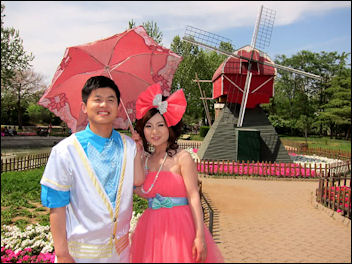
tourists at World Park Mitch Moxely wrote in the Asian Times, “In China, however, appreciation of minority cultures can quickly turn to exploitation... In places like Jiaju, a Disneyland-like atmosphere persists, and the local culture adjusts to fit Han preconceptions. Jiaju, once an isolated mountain village, was introduced to the world aftera 1998 visit by a Hong Kong traveler, who persuaded a local family to turn their home into a guesthouse. Within a few years, dozens of neighbors followed suit, converting their homes or building new hostels from scratch. [Source: Mitch Moxley, Asia Times, October 29, 2010]
Soon, tour buses began clogging the winding road to town. Logging and home-building stripped the surrounding mountainside, bringing dangerous landslides. Trash began piling up in ditches around town.
He Ming, the director of Yunnan University's Research Center of Ethnic Minorities in China's Southwest Frontier, says increased tourism helps foster development of minority regions and increases local incomes. For Han tourists, the experience of visiting minority regions provides a valuable cultural exchange that promotes goodwill between China's different ethnic groups.
But He says that governments at the federal and local levels must take steps to protect the rights and interests of the minority cultures, rather than exploit them to accommodate Han tourists.
"These cultures are unique, and an invasion of different cultures will destroy them. Furthermore, with an increasing number of tourists pouring into minority regions, the local governments commercialize the cultures, and even religious practices are changed," He says.
"Every coin has two sides," the tour operator Li says. "Profits from the tourism industry have poured into the minority regions. At the same time, cultural assimilation occurs. We make sure to tell tourists the local customs and taboos before their departure."
Foreign Tourists in China
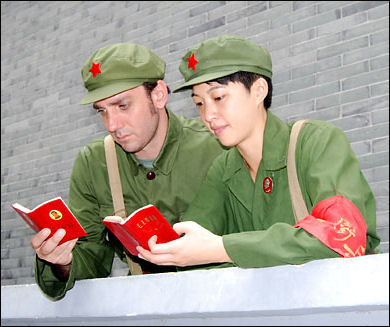
China is expected to surpass France as the world's top travel destination fairly soon. It is projected to have 186.6 million tourists in 2020. By that time it also expected to be the forth biggest source of outbound travelers. Before the Cultural Revolution China was virtually sealed off from the rest of the world.
Over 124 million overseas visitors traveled to China in 2006, up from 63.5 million in 1998. Many were Macao and Hong Kong residents making short trips to the mainland (travelers from Hong Kong, Taiwan and Macao are considered overseas travelers). The number of tourist from South Korea. Japan and Southeast Asia has been rising sharply. There were also increase from visitors form Europe, North America and India. About 800,000 people from the United States visited China in 2003. Many of them were business travelers.
Money generated from foreign tourism was $33 billion in 2006, making it six the in the world in terms of tourism earnings, up from $30 billion in 2005, $27 billion in 2004 and $10.2 billion in 1997.
Number of foreign visitors in 1996 according to the World Tourism Organization (in millions of visitors): 1) France (62); 2) the United States (46.3); 3) Spain (41.3); 4) Italy (32.8); 5) Britain (25.3); 6) China (22.8); 7) Mexico (21.4); 8) Hungary (20.7); 9) Poland (19.4); and 10) Canada (17.3). China had 24 million visitors in 1998.
In China, foreigners can partake in "cycling tours," "local dish tasting tours," "convalescent tours," and "recuperation tours." A description of a "lawyers tours" seen by Theroux read: "Any foreign friend who is interested in Chinese law and our legal system can come on this tour, attend court in session and can visit prisons...This provides them a chance to understand another aspect of China."
Recently 18 countries decided to pool their resources promote the Silk Road as a tourist attraction. There is also talk of building a new trans Asian railroad.
Top provinces for Foreign tourists in 1996: 1) Yunnan; 2) Guangdong; 3) Heilongjiang; 4) Beijing; 5) Fujian; 6) Liaoning; 7) Shanghai; 8) Inner Mongolia; 9) Sichuan; 10) Jilin.
China has waived visas for Russian tour groups as a way of making more money from Russian tourists. The Russians have a similar system in place for Chinese visitors to Russia.
Accidents Involving Foreign Tourists
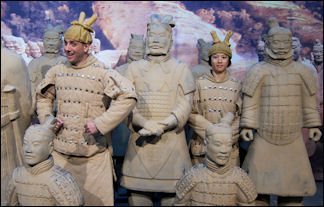
In late summer 2007 three Russian tourists died while canoeing in a remote river in the mountains of western Xinjiang Province. One member of the six person group was found alive with his body cakes in mud. Two others were missing. Autopsies determined that two of the deaths had fallen into the river and drowned.
In August 2007, three Chinese were killed and 13 Japanese tourists were hurt when a tour bus with 21 Japanese tourists collided head-on with a car in Xian., The dead included two people in the car and a tour guide on the bus. The bus was on it way from the airport to the city center. The collision took place after the car crossed over the center-line into the opposite lane,
In March 2008, a bus carrying Australian tourists was hijacked in Xian by a man armed with explosives. The man negotiated for nearly three hours before he was shot dead as he headed for the airport with 10 hostages. No one else was hurt.. No mention was made in the Chinese media of the man’s motive or the explosives he was carrying.
Ratings of Chinese Cities
According to a 1996 survey of 46 Asia-Pacific cities by the Hong Kong-based Business Traveler the ten worst cities in Asia are: Dhaka (46), Guangzhou (45), Delhi (44), Bombay (43), Karachi (42), Ho Chi Minh City (41), Shanghai (40), Seoul (39), Beijing (38) and Moscow (37). The rating was made by 1,000 completed questionnaires filled out by baseness travelers in the region who have an average income of $110,000. the top four cities were 1) Sydney, 2) Vancouver, 3) San Francisco and 4) Singapore.
Image Sources: 1,5) Nolls China website http://www.paulnoll.com/China/index.html ; 2,3) Julie Chao ; 4) Beifan.com Most from Asia Obscura
Text Sources: New York Times, Washington Post, Los Angeles Times, Times of London, National Geographic, The New Yorker, Time, Newsweek, Reuters, AP, Lonely Planet Guides, Compton’s Encyclopedia and various books and other publications.
Last updated April 2012
